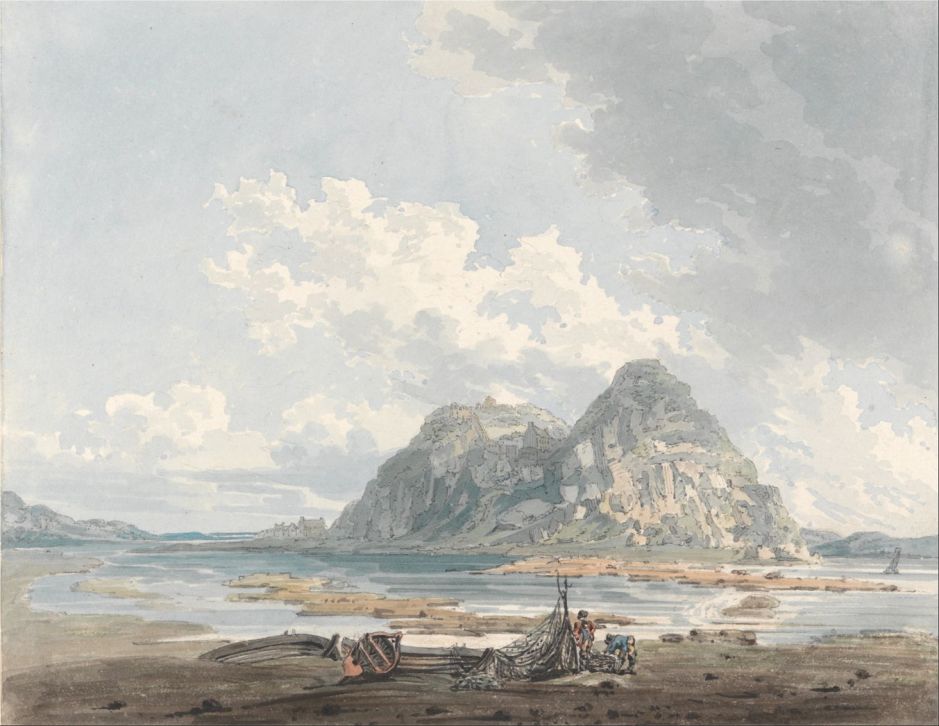In Northern Europe, seventeenth century landscape painting had been most innovative in the Low Countries, where skies came to dominate many views of flat terrain. In the south, the idealised and classical landscapes of Poussin and Claude Lorrain featured many wonderful skies, but they were kept in balance and seldom became the main theme.
Several factors were important in the shift of innovative landscape painting to Southern Europe. The climate in areas such as the Roman Campagna is more reliable and conducive to painting in front of the motif, which opened up new possibilities. At the same time, painting materials became more portable, and oil paint was moved round in ‘bladders’, enabling outdoor oil sketching to replace studies previously made using pen and ink, or other water-based media.
In the first half of the eighteenth century, artists from France and other countries started to converge on Rome, where they went out into the countryside and made the first landscape oil sketches since pioneers such as Velázquez. Sadly, most of those paintings were made on paper, and have proved too friable to survive, or have simply gone missing. Finished studio paintings by artists like Joseph Vernet have survived, though.

Vernet’s panoramic view of Charles III Hunting on Lake Licola was completed in 1746, more than a decade after the artist had arrived in Rome. It shows what is better known as Lago dei Follicoli, in Naples Province. Although this image is rather dark, Vernet seems less interested in the monarch and his shooting party in their boats, and more concerned with the sky, and the many birds in flight.

Vernet’s later paintings, such as this Italianate Harbour Scene from 1749, often devote much of the canvas to his magnificent skies. He still retains formal compositional elements, with figures in the foreground, and scenery behind, but delights in showing us these towering cumulus clouds lit so richly.
In 1753, Vernet was summoned back to Paris to respond to a royal command for a series of paintings showing the seaports of the nation.

This Coastal View is believed to have been painted after 1759, when he was still engaged in royal commissions.

In 1765, Vernet painted this finely-detailed view of Dieppe Harbour, complete with its many ships and people, as one of his series. Like the Dutch pioneers of a century earlier, he just couldn’t resist devoting the majority of his canvas to the sky.

Other artists innovated in their skying. From the same generation as Vernet, the British painter Alexander Cozens experimented with transient effects of light in his wonderful Close of the Day: Sunset on the Coast, which remarkably dates from 1768-75. This is one of his few surviving oil paintings, and like many by later plein air painters was made on paper.
In the late eighteenth century, the steady trickle of landscape painters going to paint in front of the motif in the Roman Campagna grew. Among them was perhaps the greatest of all the plein air painters, Pierre-Henri de Valenciennes (1750–1819), who arrived in Rome in 1778.

Valenciennes didn’t intend his works on paper, such as this Storm by a Lake (1780), to be seen by the public, but over a period of about four years built himself a reference library of thousands of views like this.

This is another of Valenciennes’ groundbreaking sketches from the early 1780s, Rome: Study of Clouds, one of the first examples of pure skying.

Study of Clouds over the Roman Campagna probably dates from his last months in Rome.
Valenciennes proved to have lasting influence: he taught Achille-Etna Michallon, who in turn influenced Camille Corot, and inspired him to travel to the Roman Campagna and make oil sketches in front of the motif. He also achieved more general recognition, and his 1800 treatise on landscape painting quickly became established as the standard reference, even being used by much later artists including Paul Cézanne.
Landscape painting was also becoming increasingly popular in Britain, where the precocious Thomas Girtin started producing his outstanding watercolour views.

When he was still in his teens, perhaps as young as fifteen, Girtin painted this view of Rochester, Kent: from the North (c 1790). It adheres to standard compositional principles of figures in the foreground with the scenery behind them, but his horizon is low and his art is very definitely higher in those clouds.

Some of his later watercolours, such as Dumbarton Rock and Castle from about 1793, place even greater emphasis on the sky, adopting the sort of ratio which could have passed for the Dutch Golden Age, with much flatter terrain. Tragically, though, Girtin died of asthma in 1802, and painted little in oils.
It was John Constable, just a year younger than Girtin, who became obsessed with skying. Although I’ll defer closer examination to the next article in this series, I can’t resist showing two examples here. Constable seems to have come to skying independently. He didn’t leave Britain to paint in Italy, nor was he the pupil of a master who did. But he started making oil sketches on paper as studies for finished works on canvas, and became increasingly focussed on painting the sky in all types of weather and all times of the day.

His Coastal Scene with Cliffs from about 1814 adopts the low horizon of the Dutch Golden Age, and fills the paper with clouds which are formed from coarse brushstrokes with a facture more typical of Impressionism.

Constable’s later Cloud Study, Sunset, painted during his most intense period of skying in about 1821, is even more rough and painterly, but captures the twilight brilliantly.
In the next article in this series, I will return to Constable’s skying.

